Five years ago, I/O (Input/Output, Inc.) was losing money, wallowing in debt, and acknowledging a real gap in its product portfolio for key market segments. This is when board chairman Jay Lapeyre asked fellow board member Bob Peebler to consider stepping in as President and CEO of the company. After pondering the situation, Bob set out, not only to remedy I/O’s current state, but to turn the company into a heavyweight within the geophysical industry.
Bob had some experience with whipping a company back into good shape; during the downturn in the 1980s, he was the Vice President of North American Operations for Schlumberger. He used the downturn as an opportunity to ‘retool’ the entire organization. “In just one year, Schlumberger lost the fat,” says Bob. “We changed the pricing and the sales force because we were not only selling our technologies, we had to be highly competitive to survive.”
Mapping the vision
“At the time when I was asked to lead the company, I felt strongly that we were approaching a supply and demand crunch within the energy industry,” says Bob. “This is not surprising knowing the growth in Asia and a 10-year downturn of exploration activity by the oil companies.”
“I believed there would be solid growth opportunities for the industry as a whole and I believed the upturn would likely last at least 10 to 15 years,” Bob adds. “With this in mind, I set some early goals for the company. The first would be to get us to the breakeven point by the end of 2003. Based on the company’s performance thus far, I knew this would not be easy, but was something that had to occur before we could plant hopes of raising capital.”
By the end of 2003, that first goal had been reached. Now with just over 400 employees, it was time to start building the company.
During the reorganization, Bob and his team were also busy mapping out a new strategy based on Bob’s knowledge of the industry. They needed to be in a position to take full advantage of an industry upturn and a strategy that would take advantage of some very large R&D investments, such as the new digital full wave sensor VectorSeis. The company’s products and services also needed to be broadened beyond seismic equipment.
“That summer, our digital VectorSeis program was lingering,” says Bob. “We had just one geophysicist and problems with our basic analog systems business. We needed a game-changing strategy to get things rolling and compete with the leading alternative in the market. About 70% of the known reserves were on land, yet oil companies were primarily focused on marine technology. I knew land geophysics would become a major commodity, so that year we launched the System 5 (now FireFly®) cableless system.
Another key tactic was to adopt a marketing plan to drive demand for our new acquisition technology by educating oil companies on the value of our new digital full wave measurement.”
The capital challenge
 Bob Peebler at the Durham Ranch project in Colorado, the first commercial use of FireFly®, ION’s full-wave, cableless seismic system. Photo: ION“We now had a plan after our strategy work in the summer of 2003, but the company was cash poor,” says Bob “times were pretty tough. In addition, we needed to raise capital to implement our newly minted strategy which included our acquisition targets – GX Technology and Concept Systems. We had a vision but no money to make that vision a reality.”
Bob Peebler at the Durham Ranch project in Colorado, the first commercial use of FireFly®, ION’s full-wave, cableless seismic system. Photo: ION“We now had a plan after our strategy work in the summer of 2003, but the company was cash poor,” says Bob “times were pretty tough. In addition, we needed to raise capital to implement our newly minted strategy which included our acquisition targets – GX Technology and Concept Systems. We had a vision but no money to make that vision a reality.”
Raising capital was something Bob Peebler had plenty of experience doing. In his 17-year career with Schlumberger, he started out in their summer program, then became a wireline engineer, and fast-tracked into management positions. During his first stint in the New York City office, Bob was involved with portfolio management and global coordination of their technical staff. He gained much needed insight into the financial world as well as some good connections. After several positions at other locations with Schlumberger, he came back to New York and, at the age of 40, the entrepreneurial side of him kicked into full gear. He felt he did not fit into the political mold at Schlumberger and wanted to do something different and left the company.
Later on, Bob, along with his former Schlumberger associate, Paulo Lauretti, researched Gearhart Industries, a wireline logging company. Gearhart was becoming a strong competitor to Schlumberger but the company had found itself in financial trouble during the 1980’s turndown. So, Bob and Paulo built a business plan to raise over $165 million in capital to make an offer to buy Gearhart. They made a proposal to Shearson Lehman Brothers with everything ready to be signed by October, 1987. Black Monday, October 19, struck hard when world stock markets plummeted on the signing day along with their hopes of getting their capital.
Undeterred, Bob moved on to become involved with Landmark Graphics in 1989 where he later became the CEO. He and his team were able to grow Landmark 10-fold by the time it was sold to Halliburton in 1997. He remained with Landmark Graphics as CEO, but also joined the Board of I/O in 1999.
Even after that success, something still burned inside of him to keep going. He founded Energy Virtual Partners, a company that was designed to manage oil company properties they want to keep but not invest in. They recruited top people and raised money to develop properties. “All was going well until ENRON imploded,” says Bob. “The capital we needed to run the business simply dried up.”
Drawing on these experiences, Bob tackled I/O’s capital problems. “I had developed good relations with investment bankers over the years,” comments Bob. “I gave them my vision and got people excited about the company. We had a good plan, and I was confident we would get the money we needed.”
Filling the pot holes
“Now that we were breaking even, we needed to start implementing our plan,” says Bob. “We had already launched the R&D effort for our new cableless land seismic system and it was time to acquire a high-end processing company. The oil industry was starting to pick up and we found ourselves competing for both GX Technology (GXT) and Concept Systems with bigger, well-capitalized players. GXT and Concept Systems were already marketing the sale of their companies, but both were attracted to our vision. They agreed to go out and help us raise the money and it worked. We raised the needed capital and completed the acquisition. Our next acquisition had to do with the amount of data we were going to generate with our 3-D, full-wave land seismic systems. We were able to acquire Concept Systems on the data management side of the business.”
“With the essential pieces falling into place, we started generating revenue and building a new company,” says Bob. “We went from just one geophysicist in 2003 to over 200. We now have products and services that are in demand and have become a full service seismic solutions company.”
Completing the route
“To continue building this new company, we needed to develop a strategy that was simple; we wanted to lead in the third wave of geophysical technology from an imaging perspective while at the same time build highly productive acquisition systems such as FireFly®,” says Bob.
“You need to know the ground truth,” adds Bob. “Ask lots of questions of both your people and your customers; be patient. These technology cycles tend to last a long time simply because it takes time to educate our industry, which has always been slow at adopting new technology”
Bob is still quite excited about what is happening to the company. After two successful tests of their wireless land seismic acquisition system, FireFly® went commercial at the Durham Ranch project in northwest Colorado. The area presented some challenging conditions that would be difficult, if not impossible, with a cable-based system. Evaluation of the fractured shale play required very high resolution data over an environmentally sensitive area in steep terrain: an area well suited for a cableless system.
Now ION looks quite different from what it was in the beginning of 2003. “We had new people and a new direction,” says Bob. “I wanted to change the name fairly early in the game as I felt I/O was worn out and did not represent what we had become. Various marketing people gave me similar advice: change the name when the employees and your customers sense a real change We chose the name ION to take us forward and I was pleasantly surprised at how well our employees and customers received the change. He is also proud of how everyone has responded to the challenges that confronted the ‘old’ I/O. They now have a staff that believes in the company and his vision and have become a technical leader in the digital, full-wave era in both land and marine surveys.
Learning from his experiences, Bob Peebler is an effective leader whose style is informal and approachable. While he credits much of ION’s turnaround to the people that work for him, ample credit must also be given to his competitive drive and great vision to put ION where it is today.
“Never stop learning. Reach out to others, including those outside of your industry for new ideas and then bring those ideas into practice. Listen to your customers, learn how your markets work; use what you have observed over time and you can anticipate the future.”





